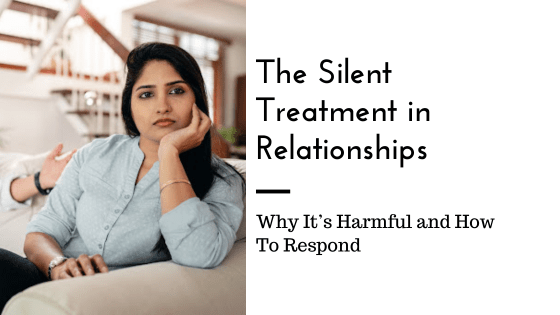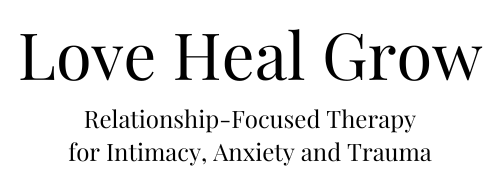
Many of our favorite shows, books, and other sources of media make it seem like relationships are only joy-filled times (or, on the flip side, an unhealthy mess of constant fighting and absolutely zero shared interests). But in reality, this simply isn’t the case.
Nothing is ever fully perfect — but that doesn’t mean it is bad. You will have disagreements with your partner at times throughout your relationship. They may even turn into arguments. But the way that you cope with these situations is what separates a healthy relationship from an unhealthy one.
Unfortunately, because many of us do not grow up surrounded by clear examples of healthy relationships — especially in the media — we may not have the healthy coping skills we would like. So, by the time we are building and maintaining relationships of our own as adults, we may rely on the methods of coping we have seen in the media as well as what we picked up as children. This brings us to our topic of the day — the silent treatment.
Whether you have heard of the silent treatment by name or not, chances are, you are familiar with it. Most likely, many of us have experienced it — being on either the receiving or giving side of the silent treatment. And, if you have not personally experienced it, you have likely seen it in your favorite show, movie, or book.
Put simply, silent treatment is a direct and harsh refusal to communicate verbally with someone — typically someone in a close relationship, such as a romantic relationship or very close friendship. Often, this refusal is used as a way to punish, control, or emotionally manipulate the other person in the relationship. And over time, continued use of the silent treatment becomes emotional abuse.
What’s the Difference Between Silence and the Silent Treatment?
Sometimes a moment of silence in a relationship can actually be a good thing — this is generally called “productive silence.” This type of silence may happen when you or your partner need to take a moment (or even a few hours or a day) to gather thoughts and cool off from a previously heated conversation. In a productive silence, you or your partner may take a few minutes to calm yourself and collect your thoughts while still taking the time to address any immediate concerns. For example, if you are feeling overwhelmed and need to take a moment, you may tell your partner that right now may not be the best time to talk about the topic, but set a time when you can come back to it together.
In other words, when silence is used to take a break from a non-productive conversation, argument, or interchange, it can be beneficial. However, when that silence is used as simply an excuse to avoid a conversation or topic and punish or dissuade someone from bringing it up, then it is manipulation. In other words, when silence is used not as a means for facilitating a more productive conversation but to upset or punish someone for saying something, it is the silent treatment.
If your partner is using the silent treatment, you may notice:
- They frequently ignore you
- They do not hide that they are ignoring you
- You never know when their extended silence will end — they do not talk to you about when you can come back to the conversation or give any indication of wanting to talk to you about anything at all
- You feel like you have to walk on eggshells around them
- Your partner talks to other people, but not you
- You feel punished when they are silent
Why Is the Silent Treatment Not a Good Idea?
Now, you may be wondering, if the silent treatment is so unhelpful for a relationship, why does it seem like your partner always relies on it when you have a disagreement?
Unfortunately, there is no simple “one size fits all” answer to this question. Your partner may rely on the silent treatment for a number of reasons. As mentioned before, the silent treatment is undoubtedly a form of emotional manipulation that can cause tension and stress within your relationship. But, not everyone turns to the silent treatment to be malicious or because they want to punish you or manipulate you.
Some individuals may not recognize these consequences and use the silent treatment simply because it is what they know. However, some people may use this refusal to communicate intentionally to undermine their partner’s self-worth, sense of belonging, and control in their relationships.
Some common reasons your partner may use the silent treatment include:
- They had experiences in the past from previous relationships or childhood traumas that have shaped their responses and coping mechanisms.
- They are experiencing emotional flooding or overwhelm caused by a painful or stressful event.
- They are unaware of their use of the silent treatment.
- They have poor communication skills and are unable to express their feelings effectively.
- They have an avoidant attachment style, post-traumatic stress disorder (PTSD), control issues, or are repressing their emotions.
- The silent treatment is your partner’s primary coping mechanism.
Responding to the Silent Treatment in Your Relationship
If you have noticed a lot of reliance on the silent treatment in your relationship, you may be wondering how you can learn to address the issues you and your partner need to talk about. In general, the best way to help reduce the amount of unwanted and unhealthy silences in your relationship is to work on building healthy communication and conflict resolution skills.
Some of the most effective ways that you and your partner can build these skills include:
- Setting healthy boundaries (and respecting each other’s boundaries)
- Creating a structured conversation or conversation script for the topics that you and your partner find difficult to discuss
- Practicing mindfulness to help you stay calm when conversations get heated
- Remembering that it is not personal — it is about something, not you as a person
If you and your partner want to work on building a stronger and healthier relationship, starting with these conversation and problem-solving skills is a great place to begin. But, if you are unsure how to begin building these skills, or you are looking for some additional support or guidance, please do not hesitate to reach out to us at Love Heal Grow today to get in touch with one of our therapists.
























